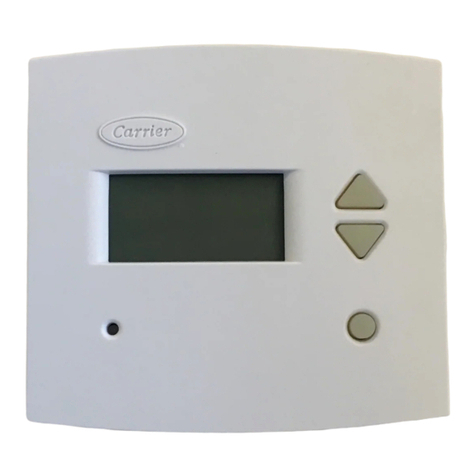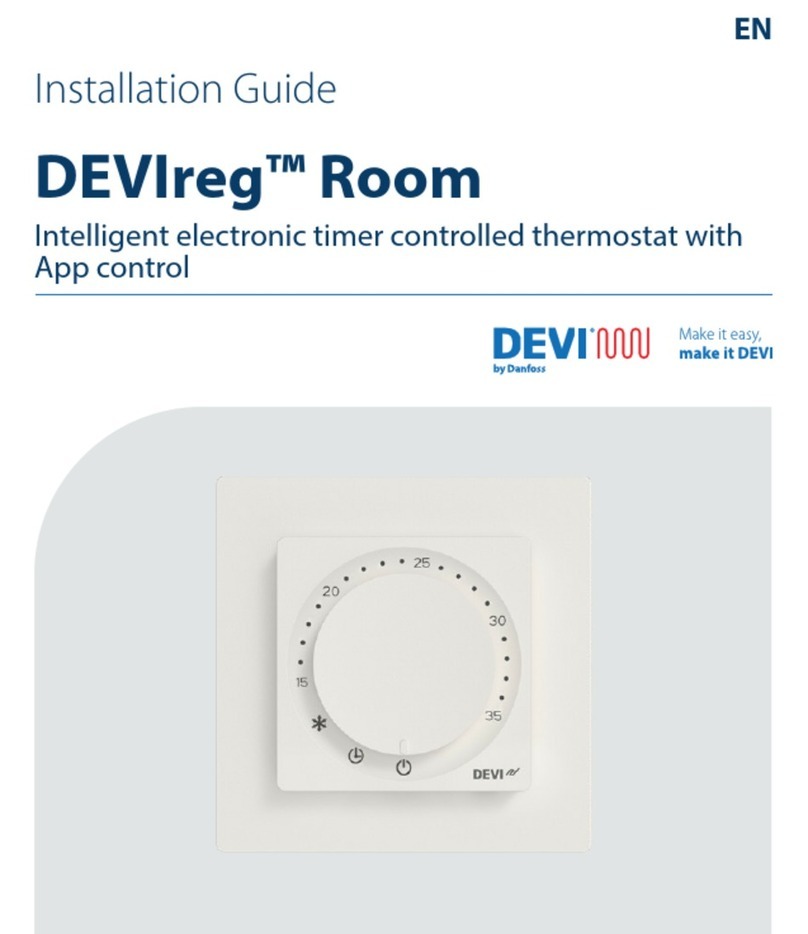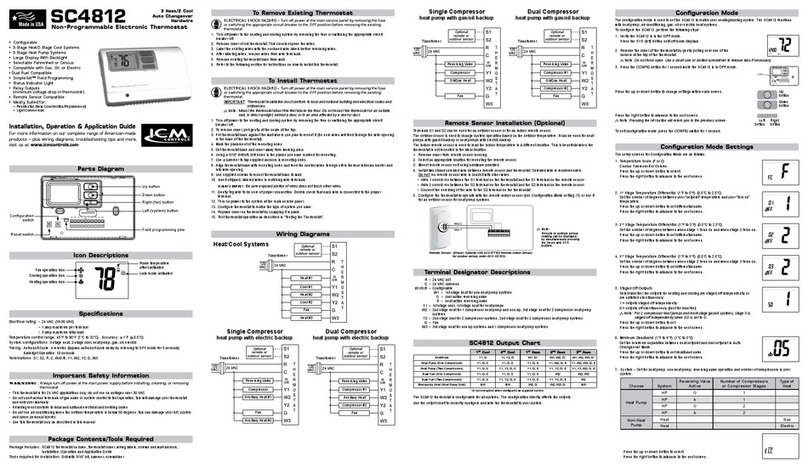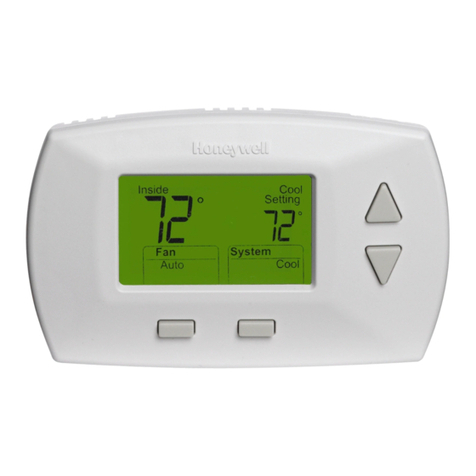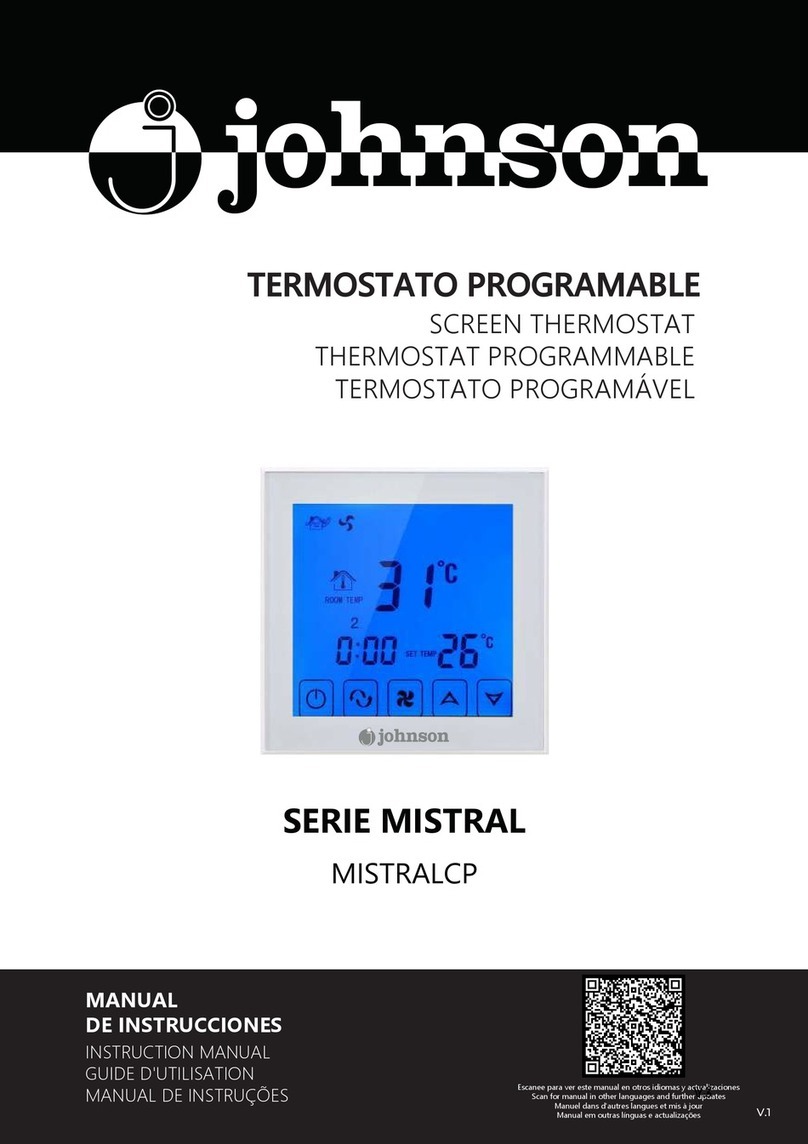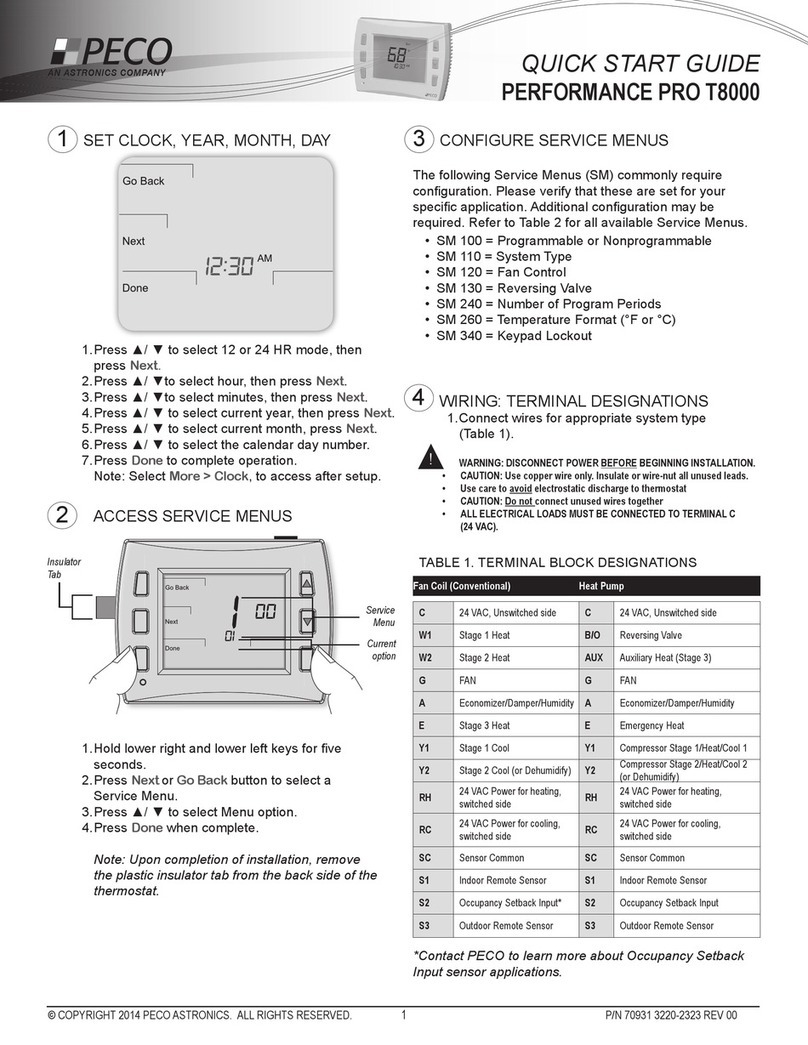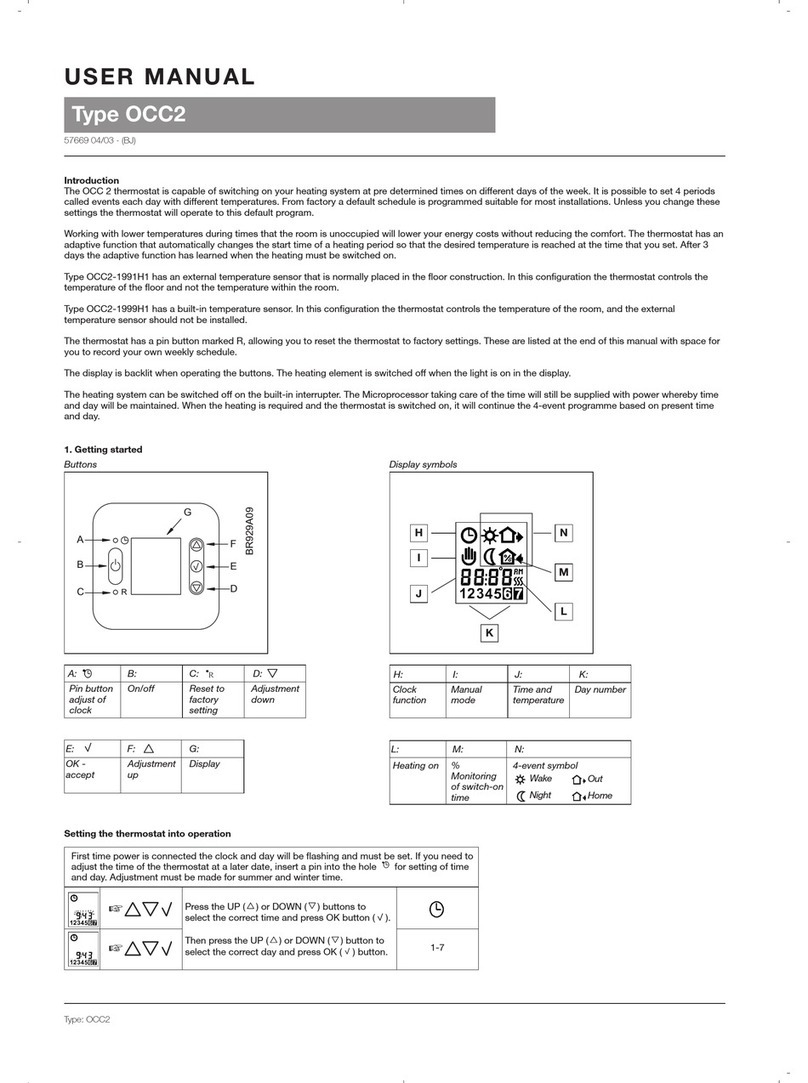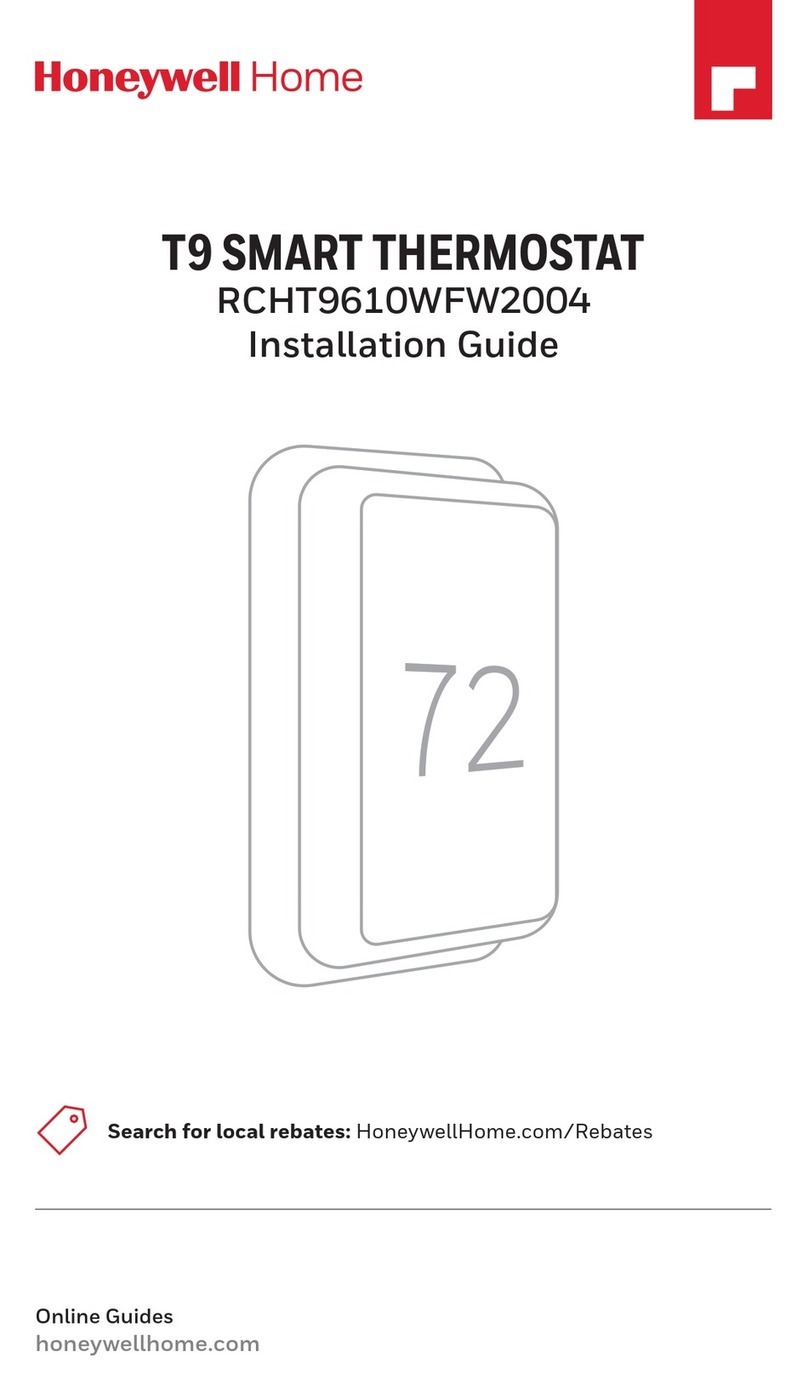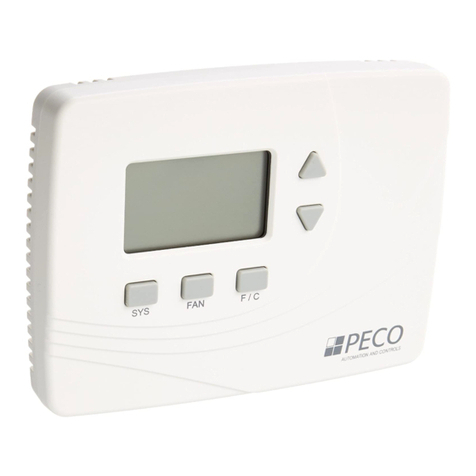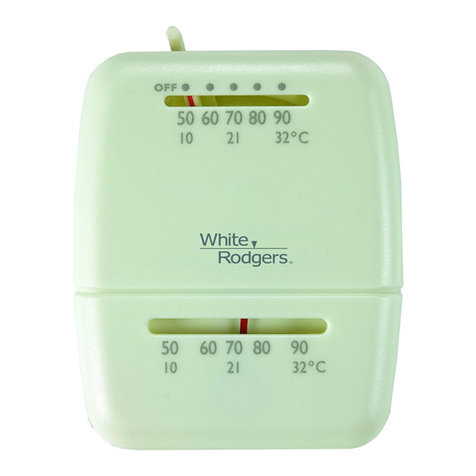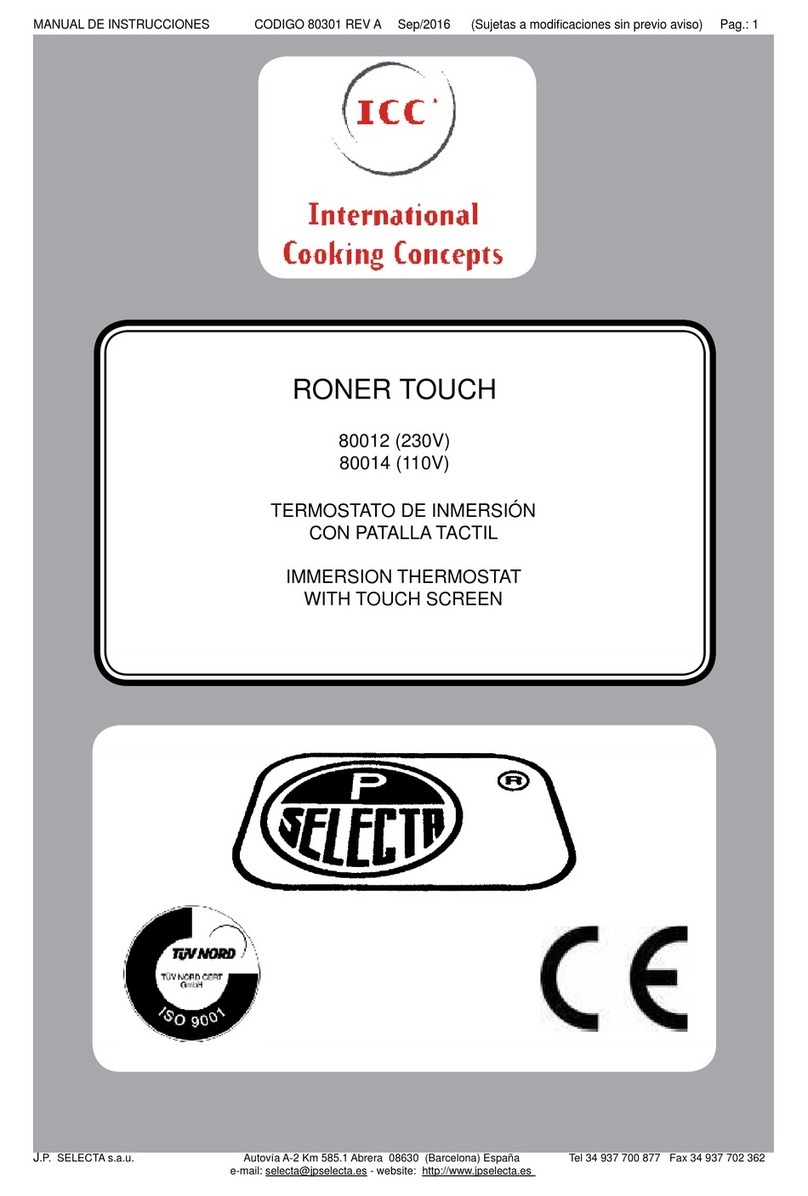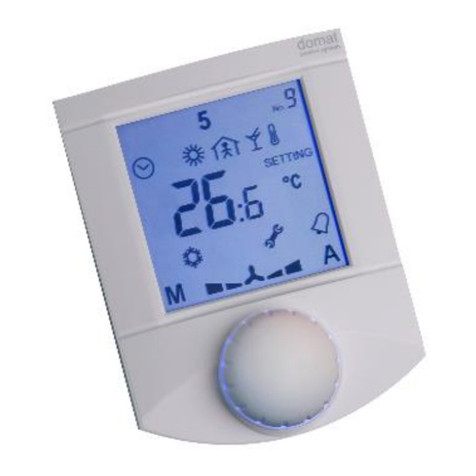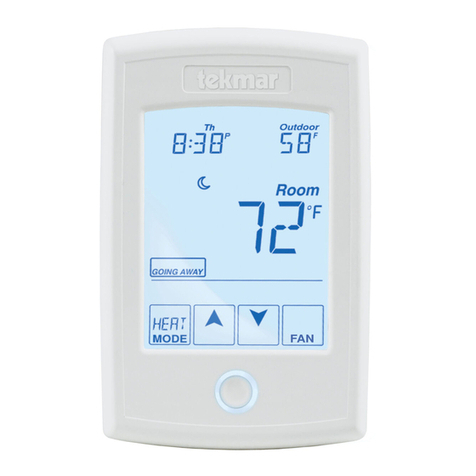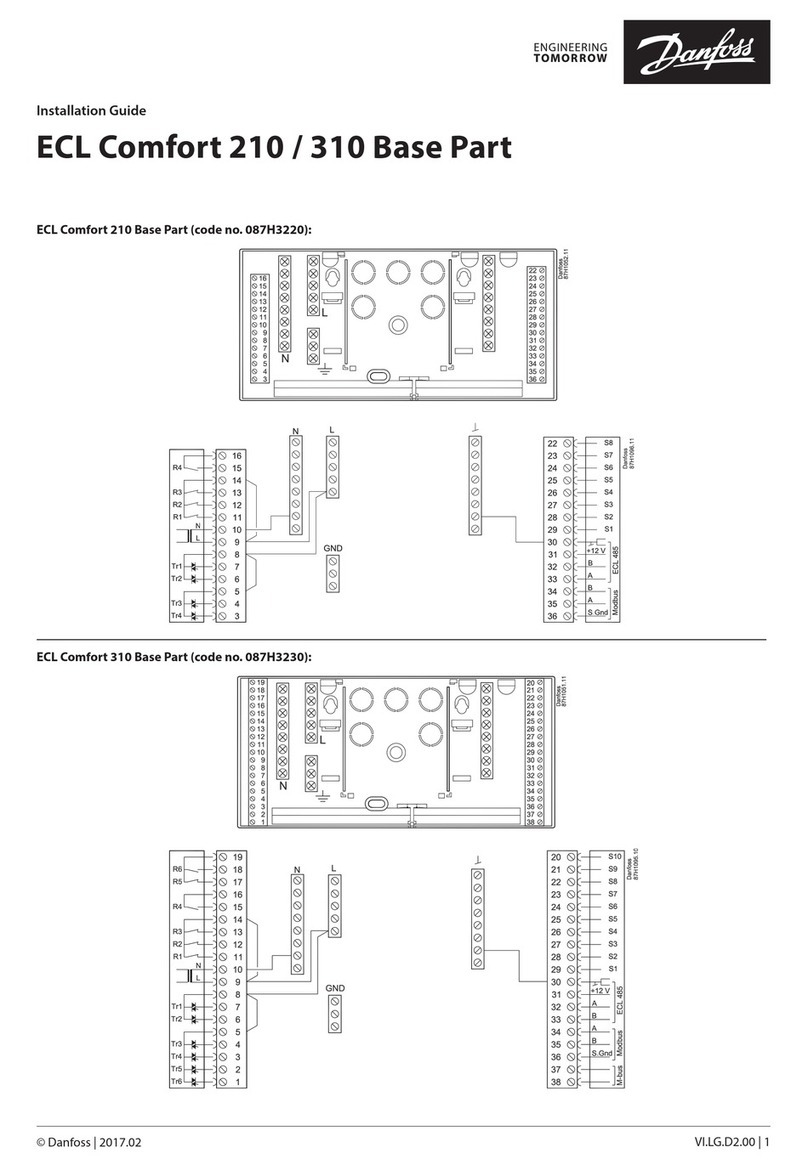Intellitec ELECTRONIC CLIMATE CONTROL II User manual

ELECTRONIC CLIMATE CONTROL II
SERVICE MANUAL Part No’s. 00-00855-000 / 00-00856-000
Intellitec 1485 Jacobs Rd.
Deland, FL 32724
386.738.7307
www.Intellitec.com - 1 - P/N 53-00855-856 Rev. C 080819
HEATHEAT
OFFOFF
LO FANLO FAN
HI FAN
HI FAN
LO COOL
LO COOL
HI COOL
HI COOL
AUTO COOL
AUTO COOL
FRONT
BOTH
REAR
FRONT
BOTH
REAR
FURNACES
FURNACES
SHEDSHED
AC 1
AC 1
ONON
SHEDSHED
AC 2
AC 2
ONON
ELECTRONIC
CLIMATE CONTROL
ELECTRONIC
CLIMATE CONTROL
75
70
TEMPERATURE
SET
TEMPERATURE
SET
Product Description
The ELECTRONIC CLIMATE CONTROL II (ECC2) System offers automatic and manual control of the A/C1 and A/C2
roof-top air conditioners and furnace/s in the motor home. The system includes an energy management system that
shuts off the air conditioners, when necessary, to prevent electrical over-load. It also includes a number of features that
provide the owner with the most comfortable temperature controlled environment possible.
In the HEAT mode, the system offers automatic control of the furnace/s in a manner identical to standard wall mount
thermostats.
In either the LOW COOL or HIGH COOL modes, the air conditioner fans run continuously at the selected speed and the
compressors are controlled to maintain the set point temperature. When in the AUTO mode, the unit automatically
controls the compressors and selects the appropriate air conditioner fan speed based on the difference between the set
point temperature and the ambient temperature in the motor home.
In addition to controlling the temperature within the coach, the system constantly monitors the current being drawn by all
of the 120 VAC electrical appliances, including the air conditioners, and will control the operation of the air conditioners to
prevent them from over-loading the circuit breakers. Once the system turns the air conditioners off, it will keep them off
until there is enough power available to restore normal operation.
The system has been designed to operate from 120 VAC, 30 Amp service only. Connecting the coach to any other
power source will cause the system to operate improperly. If only 20 Amp service is available, “load management” must
be done manually by the owner, and only one air conditioner can be operated at a time, unless the auxiliary generator is
utilized.

ELECTRONIC CLIMATE CONTROL II
SERVICE MANUAL Part No’s. 00-00855-000 / 00-00856-000
Intellitec 1485 Jacobs Rd.
Deland, FL 32724
386.738.7307
www.Intellitec.com - 2 - P/N 53-00855-856 Rev. C 080819
How It Works
The System contains two major components, the ECC Thermostat and the ECC Control Module, along with additional
external sensors which are connected to these modules.
THE ECC THERMOSTAT:
The Thermostat allows the owner to set the air conditioning and heating systems’ modes and temperature. The
electronics in this panel measure ambient temperatures via two external temperature probes (front and rear). Based on
the mode, set point temperature settings, and the temperature measured by the probes, the thermostat sends appropriate
control signals to the ECC Control Module. These signals are sent via a two wire multiplexed communication link labeled
IPX SIG and IPX GND. The Control Module then operates the air conditioners or furnace as required to maintain the set
temperature.
HEATHEAT
OFFOFF
LO FANLO FAN
HI FAN
HI FAN
LO COOL
LO COOL
HI COOL
HI COOL
AUTO COOL
AUTO COOL
FRONT
BOTH
REAR
FRONT
BOTH
REAR
FURNACES
FURNACES
SHEDSHED
AC 1
AC 1
ONON
SHEDSHED
AC 2
AC 2
ONON
ELECTRONIC
CLIMATE CONTROL
ELECTRONIC
CLIMATE CONTROL
75
70
TEMPERATURE
SET
TEMPERATURE
SET
There is a single function switch that controls the functions of the two air conditioner (A/C1) and (A/C2) systems. The
potentiometer allows the user to select a desired temperature for the system in the range of 50 to 90 degrees Fahrenheit.
Moving the controls down lowers the set point temperature. The seven-position function switch is used to select the
furnace’s and air conditioners’ operating modes.
A brief description of each mode is as follows:
HEAT - The Thermostat controls the furnace/s to maintain the desired temperature in the coach. The furnace/s will be
energized when the ambient temperature at the corresponding front or rear temperature probe is 2 degrees below
the set point temperature and shut off when the ambient temperature is at the set-point temperature. On single
furnace versions of the Thermostat (00-00856-_10) the furnace selector switch is not present. Load shedding is
not active in this mode.
OFF - All control settings are disabled and the Thermostat is placed in a low-current “sleep” mode in order to minimize
battery drain (35 - 45mA).
LOW FAN - The air conditioner fans are energized on low speed. Load shedding is active.
LOW FAN - The air conditioner fans are energized on low speed. Load shedding is active.
HIGH FAN - The air conditioner fans are energized on high speed. Load shedding is active.

ELECTRONIC CLIMATE CONTROL II
SERVICE MANUAL Part No’s. 00-00855-000 / 00-00856-000
Intellitec 1485 Jacobs Rd.
Deland, FL 32724
386.738.7307
www.Intellitec.com - 3 - P/N 53-00855-856 Rev. C 080819
LOW COOL - The air conditioner fans are energized on low speed. The compressor for A/C 1 turns on when the
ambient temperature at the front temperature probe exceeds the set temperature, and stays on until that
temperature is reduced below the set temperature. Compressor for A/C 2 turns on when ambient
temperature at the front temperature probe exceeds 1 degree above set temperature, and stays on until
that temperature is reduced below 1 degree above set temperature. Load shedding is active.
.
HIGH COOL - The air conditioner fans are energized on high speed. The compressor for A/C 1 turns on when the
ambient temperature at the front temperature probe exceeds the set temperature, and stays on until that
temperature is reduced below the set temperature. Compressor for A/C 2 turns on when the ambient
temperature at the front temperature probe exceeds 1 degree above set temperature, and stays on until
that temperature is reduced below 1 degree above set temperature. Load shedding is active.
AUTO COOL - As difference between the ambient temperature at the front temperature probe and the set-point
temperature increases, A/C functions will turn on in the following order: (Diff. Temp = Ambient
Temperature at the front temperature probe - Set-Point Temp, i.e. 2F means Room Temp is 2degrees
Fahrenheit higher than Set Temp).
Diff. Temp A/C 1 Function A/C 2 Function
0°F to +1°F Fan Low & Compressor Fan Low
+1°F to +2°F Fan High & Compressor Fan High & Compressor
Once an A/C compressor turns on, the room will have to cool by 1 degree F, in order for the A/C compressor to turn back
off (1degree F hysteresis). Both the air conditioner compressor and high fan are on when the ambient temperature goes
2 degrees above the set point temperature. When the ambient temperature drops to within 1 degree of the set point the
fan switches to low speed. When the temperature drops to the set point, the compressor turns off. When the temperature
drops 2 degrees below set point the fans will shut off. As the ambient temperature rises, the reverse procedure happens.
Load shedding is active.
INDICATOR LIGHTS:
There are two indicator lights on the control panel for each of the front (A/C1) and (A/C2) systems. The green ON
indicator will be lit when the associated function switch is in any cooling mode. The red SHED indicator will be lit
when the system calls for the associated air conditioner compressor to start. The red SHED indicators will blink
when the system is holding off operation of the air conditioner compressor during the 2 minute ”short-cycle”
protection cycle (see ECC Control Module).
THE ECC TEMPERATURE PROBES:
The temperature probes are thermistors mounted in protective plastic housings so they can sense the temperature of the
air without being influenced by the mounting surface temperature. Thermistors vary their electrical resistance inversely
with temperature: the higher the temperature, the lower the resistance. The thermistors utilized in
this system have a resistance of about 10,000 Ohms at 77 degrees.
There are two temperature probes; one for the front of the coach which controls all A/C functions,
front furnace and one for the rear which only controls the rear furnace (when so equipped). They
are located remotely from the thermostat panel to sense temperatures in the front and rear. The
temperature connections to the ECC Thermostat are via small 2 pin connectors labeled J1 (FRONT) and J4 (REAR).
Since the devices are not polarity sensitive, the two wires leading to them can be reversed without harm. However, it is
necessary to connect the front and rear temperature probes to the correct connector to ensure the ECC Thermostat
interprets the correct ambient temperatures associated with the front and rear of the coach.

ELECTRONIC CLIMATE CONTROL II
SERVICE MANUAL Part No’s. 00-00855-000 / 00-00856-000
Intellitec 1485 Jacobs Rd.
Deland, FL 32724
386.738.7307
www.Intellitec.com - 4 - P/N 53-00855-856 Rev. C 080819
THE ECC CONTROL MODULE:
The control module performs the timing, sequencing, switching, and load shedding functions for the furnace/s, air
conditioner fans and compressors. It is often located under the refrigerator. The circuitry in this module decodes the
control signals sent to it via the multiplexed communication link, IPX, from the ECC Thermostat.
48
J1
J2
J3
J5
J7
15J4
HEAT
AC2
AC2
AC1
AC1
AUX
3
HI-POT TEST
PWR UP
BYPASS POWER
TEST SW
IPX IPX WIRING
FAULT OK FAULT
The control module includes three diagnostic LED’s for ease of servicing. These LED’s are located on the center of the
board, near the edge. They are labeled “IPX FAULT”, “IPX OK, and “WIRING FAULT”.
The control module operates the furnace/s by closing a set of relay contacts which are wired to the furnace. The relay
contacts for the front furnace are connected to pins 1 and 2 of connector J4, and the contacts for the rear furnace are
connected to pins 4 and 5 of the same connector.
The relay contacts are electrically isolated from all other circuitry on the Control Module. The contacts are functionally
equivalent to the contacts on a wall mounted thermostat and are wired to the blue and black thermostat leads from each
furnace. The coach may be equipped with one or two furnaces. On coaches equipped with one furnace, the furnace
should be wired to pins 1 and 2 of connector J4.
The pigtail connector supplied with the system (PC4) utilizes the following color codes:
PC4/J4 pin FUNCTION COLOR
1 FRONT FURNACE THERMOSTAT (BLUE) WHT/BLUE
2 FRONT FURNACE THERMOSTAT (BLACK) WHT/BLK
3 KEYED – NOT CONNECTED
4 REAR FURNACE THERMOSTAT (BLACK) BLK
5 REAR FURNACE THERMOSTAT (BLUE) BLU
The control module operates the air conditioner compressors and fans via three relays with 12 VDC coils supplied by the
A/C manufacturer and mounted in their equipment. The contacts on these relays are internally wired by the A/C
manufacturer to the 120 VAC supply line for each unit and connect the compressor with the low, or high speed taps on the
fan motor to that supply line when operated. The wiring between the Control Module and these relays is low voltage (12

ELECTRONIC CLIMATE CONTROL II
SERVICE MANUAL Part No’s. 00-00855-000 / 00-00856-000
Intellitec 1485 Jacobs Rd.
Deland, FL 32724
386.738.7307
www.Intellitec.com - 5 - P/N 53-00855-856 Rev. C 080819
VDC) wiring. The Control Module uses high-side switching to operate the corresponding relays. One side of each of the
relay coils is connected together. This ”common” lead is connected to ground through the Control Module and should not
be grounded anywhere else. The other side of each of the coils is brought out to one of three separate leads. These
leads are connected to the Control Module via a four-pin connector: J2 for the A/C1 unit and J3 for the A/C2 unit. The
corresponding pigtail connectors, PC2 and PC3, are supplied with the system. PC3, the A/C2 connector, is marked in red
in order to differentiate it from PC2.
THE ECC LINE VOLTAGE SENSOR:
The ECC line voltage sensor is used by the system to detect when line voltage is available. When the line voltage is
present, the sensor outputs a DC voltage to the control module. When the line voltage is not present, the system goes to
sleep, turning off unnecessary parasitic loads to conserve battery power. The sensor is connected to J7 during normal
operations (i.e., not during HI-POT testing). This sensor should be disconnected and J7 shorted with a jumper to conduct
the HI-POT test.
The following table indicates the connection and control states:
MODULE
CONN PIN PIGTAIL
WIRE
COLOR
FUNCTION “ON”
VOLTAGE “OFF”
VOLTAGE
J2-1 BLU COMMON <1 VDC <1 VDC
J2-2 GRY LOW FAN +12 VDC <1 VDC
J2-3 GRN HIGH FAN +12 VDC <1 VDC
J2-4 YEL COMPRESSOR +12 VDC <1 VDC
J3-1 BLU COMMON <1 VDC <1 VDC
J3-2 GRY LOW FAN +12 VDC <1 VDC
J3-3 GRN HIGH FAN +12 VDC <1 VDC
J3-4 YEL COMPRESSOR +12 VDC <1 VDC
NOTE: The PC2 (J2) and PC3 (J3) pigtail wire colors are included for reference only to identify the function of the wires
emanating from the control module. The wire colors emanating from the A/C1 and A/C2 units may, or may not agree with
these colors. Always refer to the installation manual supplied with the A/C unit, or see “Identifying control lead functions
on the A/C unit”, in order to match the wire color/functions with those on the control module.
TEST SWITCH:
The control module incorporates a three-position test switch located between J2 and J3 to verify the operation and wiring
of each A/C unit only.
Sliding the test switch towards J2 bypasses the control module completely and operates the high fan and compressor for
A/C 1 by connecting J2-3 and J2-4 to +12V. If the air conditioner fails to operate in this position, the problem is with the
air conditioner or wiring between the control module and the air conditioner. Sliding the test switch towards J3 operates
the high fan and compressor for A/C 2 by connecting J2-3 and J2-4 to +12V.
The test switch must be placed in the CENTER or OFF position for normal operation.
The test switch can be used to temporarily operate the air conditioners in the event of a control module or thermostat
failure.
IPX INDICATORS:
The communication wires connecting the thermostat to the control module are protected from short circuits. However if

ELECTRONIC CLIMATE CONTROL II
SERVICE MANUAL Part No’s. 00-00855-000 / 00-00856-000
Intellitec 1485 Jacobs Rd.
Deland, FL 32724
386.738.7307
www.Intellitec.com - 6 - P/N 53-00855-856 Rev. C 080819
they are shorted, the system will not operate. To help diagnose a fault with this line, the control module includes two LED
indicators, “IPX OK” and “IPX FAULT”, associated with this circuit. Under normal operation, the “IPX OK” light should be
lit. This shows the presence of 12 volts and signal available at the output of the control module. If the IPX
communication line between the thermostat and the control module is shorted to ground or +12 volts, the “IPX OK” LED
will be out and the “IPX FAULT” LED will be lit. If neither is on, the 12 volt supply is probably missing.
WIRING FAULT INDICATOR:
The 12 volt wires feeding the air conditioners are protected from short circuits. If any of these wires are shorted to
ground, the “WIRING FAULT” indicator will be lit indicating the short. To help locate the short, the plugs feeding the air
conditioners should be unplugged, one at a time, to see which cable is at fault. When the shorted cable is unplugged, the
“WIRING FAULT” indicator will go out and the other air conditioner will operate normally. The individual wires of the
shorted plug can be tested for shorts to find which one is at fault.
The “SHORT” indicator operates in the “OFF” and “TEST” modes of the TEST SWITCH.
The Control Module also includes two minute timers for each air conditioner to eliminate the possibility of short-cycling the
A/C compressors. Short-cycling causes undue stress on the compressor motor when refrigerant pressures are not
allowed to stabilized prior to restarting the compressor.
The timer is started each time one of three conditions is encountered:
1) If the Control Module shuts down the associated A/C compressor during the shedding sequence.
2) If the 120 VAC line voltage sensed by the Line Voltage Sensor goes off. This will occur during an interruption
of power, if the generator is not running, or if the shore power cord is not plugged in.
3) If the unit is recovering from load-shedding, the Control Module will signal the ECC Thermostat to alternately
flash the red SHED indicator on the control panel. The Control Module will not allow the compressor to be re-
energized until the two-minute period has elapsed.
LOAD SHEDDING:
An important feature included in the control module is the automatic load shedding function. This circuitry measures the
total current being drawn by all of the 120 VAC operated equipment in the coach being fed through the main panel. The
current sensor is mounted in the main panel and supplies an input signal to the control module. When enough 120 VAC
appliances are operated so that the current exceeds 30 Amps for more than approximately 5 seconds, the control module
begins to shed (shut off) the A/C compressors and fans to bring the current back below the 30 Amp limit. This prevents
nuisance tripping of the main 30 Amp breaker.
The shedding sequence occurs in the following order:
1. (A/C2) compressor (if running)
2. (A/C1) compressor (if running)
3. (A/C2) fan (if running)
4. (A/C1) fan
When the Control Module sheds any of the loads, it returns a signal to the thermostat to light the corresponding A/C1 or
A/C2 ”SHED” indicator. Based on the shedding sequence, the A/C2 ”SHED” indicator will always be the first to light. If
enough appliances are operated to generate a load current of 30 Amps, the control module will proceed through the entire
shedding sequence and essentially shut down both A/C compressors and fans. It is important to note that if the
control module has shed all four loads and the line current continues to exceed the 30 Amp limit, it is likely that
the 30 Amp line breaker will open.
Current
Sensor

ELECTRONIC CLIMATE CONTROL II
SERVICE MANUAL Part No’s. 00-00855-000 / 00-00856-000
Intellitec 1485 Jacobs Rd.
Deland, FL 32724
386.738.7307
www.Intellitec.com - 7 - P/N 53-00855-856 Rev. C 080819
SYSTEM INTERCONNECTS:
12 VDC power is supplied to the control module via connector J1. This connector also provides the signal connections
between the control module and thermostat and the current sensor. Connector PC1B is part of the current sensor
assembly.
The pigtail connector, PC1A, is supplied with the system and is wired per the following table:
J1 PIN PC1B PIN FUNCTION COLOR
1 1 CURRENT SENSOR IN WHT
2 2 CURRENT SENSOR GND WHT
J1 PIN PC1A PIN FUNCTION COLOR
3 1 KEYED – NOT CONNECTED
4 2 +12 VDC POWER RED
5 3 KEYED – NOT CONNECTED
6 4 POWER GROUND BLK
7 5 IPX GND BRN
8 6 IPX SIG YEL
THE ECC CURRENT SENSOR:
The current sensor is a transformer which converts the AC current passing through
its core into a corresponding voltage. A functional current sensor has a resistance
of approximately 15 - 40 Ohms and produces an AC voltage of 0.1 VAC per Amp of
current passing through the core (10 Amps = 1.0 VAC). The current sensor should
be mounted in one of the knockouts in the 120 VAC box so that the donut shaped
head is inside the box. The black wire feeding the 30 Amp main breaker in the 120
VAC panel should pass through the hole in the current sensor.
USE WITH 5 KW GENERATOR
In systems using 5 KW generator sets, an additional change-over, or transfer relay, is used to transfer the load of one of
the A/C system (usually the A/C1 system) to the generator’s second output to utilize generator’s full output capability. In
this situation, the ECC load shedding features will remain unchanged, but the current sensor will not measure the load
current going to the larger, A/C1 system when the generator is running. If the measured load currents through the current
sensor continue to exceed 30 Amps with the A/C2 system shed, the ECC Control Module will shed the A/C1 system to
prevent overload of the generator.
Current
Sensor

ELECTRONIC CLIMATE CONTROL II
SERVICE MANUAL Part No’s. 00-00855-000 / 00-00856-000
Intellitec 1485 Jacobs Rd.
Deland, FL 32724
386.738.7307
www.Intellitec.com - 8 - P/N 53-00855-856 Rev. C 080819
20A30A 20A 15A 15A 15A
RELAY CONTROLLED
AIR CONDITIONER
A/C1
LOW VOLTAGE
WIRING
HEAT
HEAT
OFF
OFF
HI FAN
HI FAN
LO COOL
LO COOL
HI COOL
HI COOL
AUTO COOL
AUTO COOL
FRONT
BOTH
REAR
FRONT
BOTH
REAR
FURNACES
FURNACES
SHED
SHED
AC 1
AC 1
ON
ON
SHED
SHED
AC 2
AC 2
ON
ON
ELECTRONIC
CLIMATE CONTROL
ELECTRONIC
CLIMATE CONTROL
75
70
TEMPERATURE
SET
TEMPERATURE
SET
RELAY CONTROLLED
AIR CONDITIONER
A/C2
LOW VOLTAGE
WIRING
TRANSFER
RELAY
DELAY
00-00568-000
5.0kW GENERATOR
LOW VOLTAGE
WIRING ECC
CONTROL
MODULE
00-00855-000
30 AMP
SHORE
POWER
CORD CHANGE-
OVER
CURRENT
SENSOR
BREAKER BOX
MAIN AC1 AC2 BR1 BR2 BR3
120VAC LINE
SENSOR
87-01001-112

ELECTRONIC CLIMATE CONTROL II
SERVICE MANUAL Part No’s. 00-00855-000 / 00-00856-000
Intellitec 1485 Jacobs Rd.
Deland, FL 32724
386.738.7307
www.Intellitec.com - 9 - P/N 53-00855-856 Rev. C 080819
Symptom Possible Cause / Remedy
No green “ON” indicator, Thermostat in any functional
position Reset circuit breakers in Main distribution box.
Diagnostic “IPX OK” LED on the control module is NOT on:
If “IPX FAULT” LED is NOT on,
1) Check the 5A fuse in the distribution panel for
control module power.
2) Check for +12VDC at pin 2 of J1 on control
module and ground at pin 4. Make sure that
the power connector (PC1A) is plugged into J1
on the control module. Make sure that the
pigtail keying matches connector keying.
3) Check voltage at the line sensor input (J7). It
should be greater than 11 volts.
4) Measure the DC voltage between the Power
(J1-4), IPX SIG (J1-8) and IPX GND (J1-7) pins
on the control module. There should be
approximately 12 volts from IPX GND to Power
and 9 volts from IPX GND to IPX SIG. The
same voltages should appear at the
Thermostat. If not, repair wiring.
5) Replace control module.
If the “IPX FAULT” LED is ON: - This indicates a short
in the wiring between the control module and the
thermostat. Check the wiring for the short and repair.
Red “Shed” indicator always ON 1) Appliances drawing too much current to allow
air conditioners to operate.
2) Current sensor not connected or open. Repair
or replace.
3) Another device in the IPX system is
programmed for Module P and is currently
active.

ELECTRONIC CLIMATE CONTROL II
SERVICE MANUAL Part No’s. 00-00855-000 / 00-00856-000
Intellitec 1485 Jacobs Rd.
Deland, FL 32724
386.738.7307
www.Intellitec.com - 10 - P/N 53-00855-856 Rev. C 080819
“ON” indicator is lit, but the A/C compressor never
comes on in either the LOW COOL, HIGH COOL, or
AUTO COOL mode, even when the set point control is
set to its lowest (cool) position. In the HEAT mode, the
furnace works properly in conjunction with the set
point control.
A. Slide the test switch on the control module towards J2.
A/C1 compressor and high fan should turn on.
If NOT: 1) Check to make sure that the leads on PC2 are
connected to their corresponding function at
the A/C1 unit. The wire colors may or may not
match. It is likely that the “common” and ”high
fan” leads are reversed.
2) Check the continuity of the ”Comp Relay” lead
between the control module and the front A/C
unit.
B. Slide the test switch on the control module towards J3.
A/C2 compressor and high fan should turn on.
If NOT: 1) Check to make sure that the leads on PC3 are
connected to their corresponding function at
the A/C2 unit. The wire colors may or may not
match. It is likely that the ”common” and ”high
fan” leads are reversed.
2) Check the continuity of the ”Comp Relay” lead
between the control module and the A/C2 unit.
C. Check to make sure that the connector, PC1B, from the
current sensor is plugged into J1, pins 1 and 2 and that the
120 VAC supply lead to the 30 Amp breaker in the
distribution panel passes through the hole in the current
sensor.
If OK then:
Unplug the current sensor from the control module
and measure the resistance across the leads to
the current sensor. The resistance should be
approximately 40 Ohms.
If NOT: Replace the current sensor.

ELECTRONIC CLIMATE CONTROL II
SERVICE MANUAL Part No’s. 00-00855-000 / 00-00856-000
Intellitec 1485 Jacobs Rd.
Deland, FL 32724
386.738.7307
www.Intellitec.com - 11 - P/N 53-00855-856 Rev. C 080819
“ON” indicator is lit, but the furnace does not operate
in HEAT mode at any thermostat setting. A. Check the fuse or circuit breaker feeding the furnace.
B. Move the set point control up to the highest and down to
the lowest temperature settings. Somewhere in between
these settings an audible click should be heard from the
relay in the control module.
If NOT: Replace the control module.
C. Disconnect plug PC4 from the control module. Placing
a shorting jumper between PC4 pins 1 and 2 should cause
the front furnace to energize. Placing a shorting jumper
between PC4 pins 4 and 5 should cause the rear furnace to
energize.
If NOT: Check the wiring between PC4 and the furnace.
“ON” indicator is lit, air conditioners won’t function
properly, “SHORT” indicator on the control module is
“ON”.
One or more of the wires to the air conditioner/s are shorted
to ground.
1) Unplug either air conditioner connector (J2 or
J3) from the control module to see if the
“SHORT” indicator goes out. The other air
conditioner should operate normally.
2) Check individual wires of suspect connector for
short to ground.
3) Repair short in wires.

ELECTRONIC CLIMATE CONTROL II
SERVICE MANUAL Part No’s. 00-00855-000 / 00-00856-000
Intellitec 1485 Jacobs Rd.
Deland, FL 32724
386.738.7307
www.Intellitec.com - 12 - P/N 53-00855-856 Rev. C 080819
ELECTRONIC
CLIMATE CONTROL
ELECTRONIC
CLIMATE CONTROL
75
70
TEMPERATURE
SET
TEMPERATURE
SET
CURRENT SENS OR
P/N 01-00703-200
120VACLINE
TO MAIN BREAKER
120VAC LINE
FR OM CHANGE
OVER DE VICE
120VACNEUTRAL
2003 ECC MASTER
P/N 00-00855-000
HIGH HIGHLOW LOWCOMP COMP
A/C2UNIT A/C1 UNIT
RELAYS BUILT INTO A/C UNIT RELAYS B UILTIN TO A /C UNIT
WHITE
WHITE
RED
+12VOLTPOWER
BROWN
YELLOW
WHT/BLU
BLU
WHT/BLK
BLK
TOFRONT
FURNACE
TO REAR
FURNACE
BLACK
PWR GRND
120VAC Line Sensor
P/N 87-01001-012
BLK
BLKw/ WHT Stripe
COMMON(BLU)
COMMON (BLU) COMP RLY (YEL)
COMPRLY (YEL)
LOW FAN RLY (GRY )
LOWFAN RLY (GRY) HIFANRLY(GRN)
HIFAN RLY (GRN)
TEMPERATURE
SENSOR
P/N 00-00569-000
TEMPERATURE
SENSOR
P/N 00-00569-000
WHT
WHT
WHT
WHT

ELECTRONIC CLIMATE CONTROL II
SERVICE MANUAL Part No’s. 00-00855-000 / 00-00856-000
Intellitec 1485 Jacobs Rd.
Deland, FL 32724
386.738.7307
www.Intellitec.com - 13 - P/N 53-00855-856 Rev. C 080819
PART DESCRIPTION INTELLITEC
PART NUMBER FLEETWOOD
PART NUMBER
Single Furnace Thermostat 00-00856-_10 F80-0026
Dual Furnace Thermostat 00-00856-_00
Control Module
(11k/13.5k BTU air conditioner) 00-00855-000 F97-00XX
Current Sensor 01-00703-200 F93-2000
Temp Sensors (2) 00-00569-000 F93-2021
Temp Probe Cables (2) 10 ft. 11-00417-010 F07-9713
Temp Probe Cables (2) 31 ft. 11-00417-031 F07-9711
Temp Probe Cables (2) 50 ft. 11-00417-050 F07-9712
Temp Probe Cables (2) 65 ft. 11-00417-065 F07-9714
Transfer Relay Delay 00-00568-000 F97-0060
Wiring Harness Kit 11-00375-000 F07-0150
Line Voltage Sense Kit 11-00855-000

ELECTRONIC CLIMATE CONTROL II
SERVICE MANUAL Part No’s. 00-00855-000 / 00-00856-000
Intellitec 1485 Jacobs Rd.
Deland, FL 32724
386.738.7307
www.Intellitec.com - 14 - P/N 53-00855-856 Rev. C 080819
This manual suits for next models
2
Table of contents
